🧬Concept of evolution🧬
The discovery of fossil remains of animals and plants that lived in remote times, as well as the identification of geological eras according to the type of layers or sediments found, led many researchers to believe that living forms have evolved through the ages. Indeed, it has been possible to reconstruct complete series of fossils that show a progressive development from simple forms of life to more complex forms. But not only living beings have evolved, organic evolution, but the universe itself: stars, planets, satellites, have undergone great changes and alterations in the course of time. These changes constitute the cosmic evolution.
According to these considerations, we can define evolution as a process of continuous and progressive change of the characters of species over time and from simpler forms
The theory of evolution holds that current species derive from other remote species that underwent modifications.
Both organic and cosmic evolution has not yet ceased; the universe and living beings continue to evolve, it is a continuous process. At the present time, species are evolving, even if man does not perceive these changes.
Everything on earth evolves; not only the species as such, but also the ecological levels: the population, the community and the ecosystem itself, which we consider as the most stable level of organization, also undergoes changes and alterations.
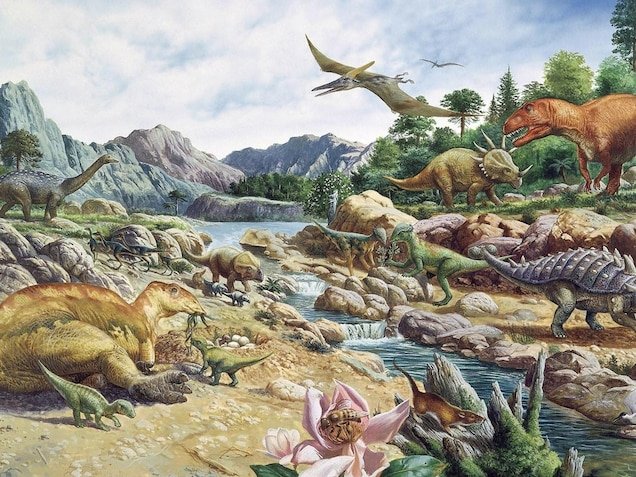
Landscape of the Mesozoic Era
Source
🧬History of evolutionary ideas🧬
Some Greek philosophers had evolutionary ideas, but due to the little development of science, they did not delve into this subject. It was the geologists who prepared the change for the theory of evolution. One of the most influential was James Hulton (1726-1797). Hulton proposed that the earth had not formed suddenly and violently, but by slow and gradual processes-wind, rain, crustal movements, and water currents-the same processes that are currently at work in the world. Hulton's theory, which was called actualism, was important for two reasons:
(a) It implied that the earth has a long history. This was a new idea, since the age of the earth was thought to be much younger (5,000 years) and this period of time is not long enough for any kind of evolution to have taken place.
b) He made it clear that change is the "normal" in the course of events, as opposed to the concept of a static system, interrupted by an extraordinary and occasional event.
Towards the end of the 17th century, a great interest in fossils arose. In previous centuries, fossils had been collected as curiosities, but in general they had been considered either as accidents of nature - stones that, in a sense, resembled shells - or as evidence of great natural cataclysms, such as the Flood.
Among the first to suggest that species might have undergone some changes over time was the French scientist George Louis Leclerc de Buffon (1707-1788). Buffon believed that these changes took place by a process of degeneration. He suggested that, in addition to the numerous organisms that were the product of a special creation at the beginning of the world, "there are a smaller number of families conceived by nature and produced by time." Indeed, as he himself summarized. perfection and degeneration are one and the same thing, since both phenomena imply an alteration of the original construction....
Another of the first to question the fixity of species was Erasmus Darwin (1737-1802), grandfather of Charles Darwin. Erasmus Darwin argued that species have historical connections with each other, that competition plays an important role in the development of different species, that their offspring can change in response to the environment in which they live, and that their descendants can inherit these changes.
Theories of the origin of species include: fixism, Lamarckism, Darwinism or the theory of natural selection, and the synthetic theory of evolution.
.jpg)
Carboniferous period forest
Source
🧬Fixist or creationist theory🧬
The fixist theory maintains the immutability of species, i.e., that they do not vary in time or space. Charles Linnaeus (1707-1778) was a convinced fixist, but in his works, he lets us glimpse a certain transformism. Indeed, he realized that each species can be placed according to its characters between one that precedes it and another that follows it in organization, i.e., that living beings could be placed in a gradual succession of forms.
This concept was later clarified by Buffon in his famous aphorism "nature does not make leaps".
After Linnaeus, Cuvier, the father of comparative anatomy, supported the fixist theory. He argued that the world had been the scene of great cataclysms that destroyed the existing beings, which were replaced by others, but ensuring that the repopulation was made with the remains of each flora and fauna destroyed, not admitting new creations.
This theory has recently reemerged in some circles.
🧬Lamarckian Theory or Lamarckism🧬
The first scientist to develop a systematic theory of evolution was Jean Baptiste Lamarck (1744-1829). In 1801 he formulated a complete theory of transformism according to which complex organisms evolved from simple forms, including man.
Lamarck, unlike most zoologists of his time, was particularly interested in unicellular organisms and other invertebrates, and it is undoubtedly that his in-depth studies of these "simpler" life forms led him to consider living organisms in terms of an ever-increasing complexity, with each form originating from another.
Like Cuvier and others, Lamarck noted that the oldest rocks contained the simplest forms of life, but, unlike Cuvier, he interpreted this to mean that the higher forms had arisen from the simpler ones. Lamarck based his theory on:
The inheritance of acquired characters: the organs of animals became stronger or weaker, i.e., stronger or weaker according to use or disuse. These changes, according to Lamarck's theory, were transmitted from parents to offspring. His most famous example, and the one often used by Cuvier to ridicule him, was that of the giraffe which stretched its neck longer and longer to reach the leaves of tall trees and transmitted this lengthened neck to its descendants, who, in turn, lengthened their necks and so on.
The second important factor in Lamarck's theory of evolution was that of a universal creative principle, an unconscious upward effort in the scale of nature that propelled each creature toward greater complexity. Every amoeba was on the way to man.
Lamarck's concept of the inheritance of acquired characters is attractive. Darwin made use of it, consciously or unconsciously, and indeed in successive editions of The Origin of Species he shows that he was influenced in this particular Lamarckian view. Lamarck's theories endured into the 20th century.
Is there any experimental evidence to support Lamarck's hypothesis?
Despite repeated efforts to prove that the characters acquired by an individual can be transmitted to his descendants, no evidence has yet been discovered.
The first experiments carried out to try to solve the problem consisted in surgically removing certain parts of the body, for example, the tail of a mouse.
Even after such an operation was performed over several generations, the mice were always born with tails, which continued to be as long as usual. The same thing happens with the tails of dogs and sheep, even if they are cut off, they continue to appear in the descendants. All this proves that acquired characters are not inherited.
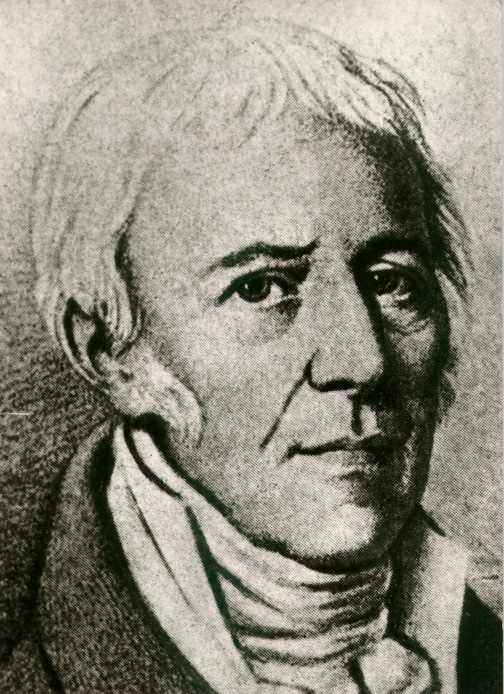
Jean Baptiste Lamarck
Source
🧬Darwin's theory of natural selection🧬
In 1859, the English naturalist Charles Darwin (1809-1882) published the book The Origin of Species, in which he expounded his theory of evolution by natural selection.
This book was a summary of his research and the conclusions he had reached, after years of in-depth studies on natural history, during his famous journey through different parts of the planet.
Indeed, Charles Darwin made a long voyage around the world on the steamer "Beagle".
the world on the steamer "Beagle". During this voyage he made many
many observations he made on the areas visited and many samples of plants and animals
and many samples of plants and animals he collected,
mainly in the Galapagos Islands (Pacific Ocean). From his observations and the biological material he collected and carefully studied, Darwin
and carefully studied, Darwin drew a series of con- clusions, which represent a change in his
and carefully studied, Darwin drew a series of conclusions, which represent a change in the conception of the world and of living beings.
of the world and of living beings.
Darwin observed the existence of variations in species, stating that they were not
variations in species, stating that the causes of these variations were unknown.
variations were unknown.
Natural selection acts where there is competition between individuals, i.e., the
between individuals, i.e., the struggle for life. In this
In this struggle for life, the weakest is eliminated and the strongest survives (survival of the fittest).
survival of the fittest)**.
Darwin attributes to this mechanism the improvement or evolution of primitive species, until reaching the high degree of development and organization of the present species. Biologists followed this theory with interest. Von Baer stated "that the history of nature is the history of continuous progress from less perfect to more perfect forms".
There are two parts to Darwin's theory: the idea of evolutionary change and the idea of natural selection. To begin with, Darwin rejected the notion that living things are immutable, the product of a sudden creation. On the contrary, he argued that change is the norm; therefore, present-day organisms are descended by gradual change-from very ancient ancestors of very different appearance and form and less complex.
Secondly, natural selection determines the changes that occur, or in other words, natural selection directs evolution. This selection is influenced, among other factors, by the following:
(a) lack of living space and competition give rise to the struggle for existence.
b) in this struggle, the fittest triumph because they are the ones with the most suitable organization for the environment in which they live.
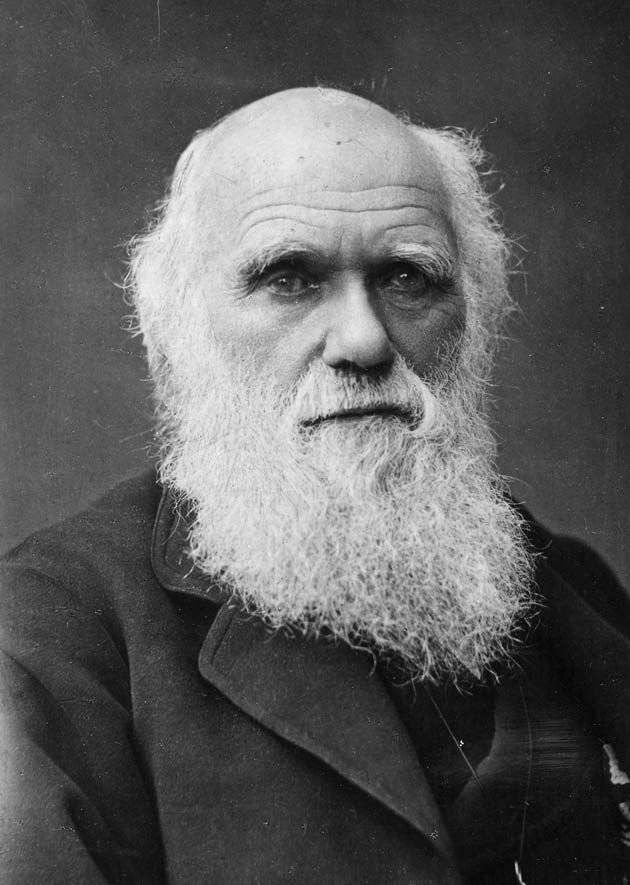
Charles Darwin
Source
🧬Theory of mutationism 🧬
A new advance in the theory of evolution is achieved with the theory of mutations proposed by Hugo de Vries. According to this theory, living beings, besides evolving in a gradual, continuous and not very intense way, can evolve in a rapid, abrupt and discontinuous way. Mutations are precisely the alterations of genes that appear abruptly in one or more individuals of the same species, affecting the genotype. They do not obey the rules of fluctuations, which is why they have also been called discontinuous variations.
Modern theories, in order to explain evolution, attribute variations to internal causes of the organism. These variations pursue a determined plan, which is explained by the organic finality or finalism that presides over the life of living beings, as well as their progressive evolution in time.
Evolution is a vital and finalistic process, which has tried to achieve forms not only adapted to the environment, but progressively more complex. This finalistic principle is based on the geological history of the world, which shows us that living beings evolve through time.
We have already mentioned above the causes that can lead to mutations and the types of mutations that exist. Polyploidy, which consists in the number of chromosomes in the cells of an organism being multiple of the haploid number of chromosomes of the species, can be considered as a true mutation.
Polyploidy is usually accompanied by gigantism, or at least by an increase in size. The study of these variations makes it possible to explain that the differences that distinguish breeds and varieties of domestic animals and cultivated plants are due to mutations that have been perpetuated by heredity, following Mendel's laws.
Synthetic theory of evolution
The modern theory of evolution, also called synthetic theory, is a synthesis of knowledge and evidence provided by Darwin's natural selection, mutationist theory and modern genetics.
Natural selection constitutes a direct and organizing process that gives rise to complex and highly organized beings, while mutations and recombination produce the variability of species.
The synthetic theory of evolution was formulated in its fundamental postulates around 1930. Because of the universality of these postulates and because it is based on the knowledge and data provided by various sciences such as paleontology, geology, systematics, genetics, and ecology, it is widely accepted.
Biological evolution occurs as a consequence of the struggle for the survival of the fittest (natural selection) and the variations in the characters of the species (mutations) that have occurred through the ages since the appearance of life on earth some 3000 million years ago.
Man is also a product of evolution, as evidenced by the development of our brain, which in about six million years has tripled in volume.
T.H. Dobzhansky (1900-1975), who brought together all the genetic discoveries supporting Darwinism, and Fisher, who harmonized Darwin's observations with Mendelian inheritance, contributed to the development of the synthetic theory of evolution.
The vertiginous development of molecular genetics led to the birth of new theories, such as that of M. Kimura, who proposed that part of the variability is not subject to natural selection. This neutralist view, although initially opposed, is now being accepted by many scientists.
Evolution is a fact and for the time being Darwin's theory, with some modifications, is the most satisfactory and almost universally accepted by all schools of thought.
🧬Evidence for evolution🧬
a) Paleontological evidence
The oldest fossils reveal that in the various geological epochs animals and plants appear in a certain order, starting from the simplest to the most complex organization.
Fossils have been able to be identified and ordered according to their antiquity by the methods of carbon 14 (C¹⁴) and other radioactive isotopes such as uranium (U²³⁵), Thorio²³², etc.
If we take vertebrates as an example, we have that to each period of terrestrial history corresponds and characterizes a class of vertebrates, beginning with fish, until culminating with the appearance of mammals. The same can be said of plants, which begin with bacteria, then algae, fungi, pteridophytes, gymnosperms and angiosperms.
In the case of the horse, it has been possible to follow in fossils the successive transformation of teeth and legs from the Eocene to the present time. The folds of the molars of present-day horses are more complex than those of fossils. Regarding the toes of their limbs, the fossils present five toes and then become smaller and smaller until culminating in the present form, with only one toe.
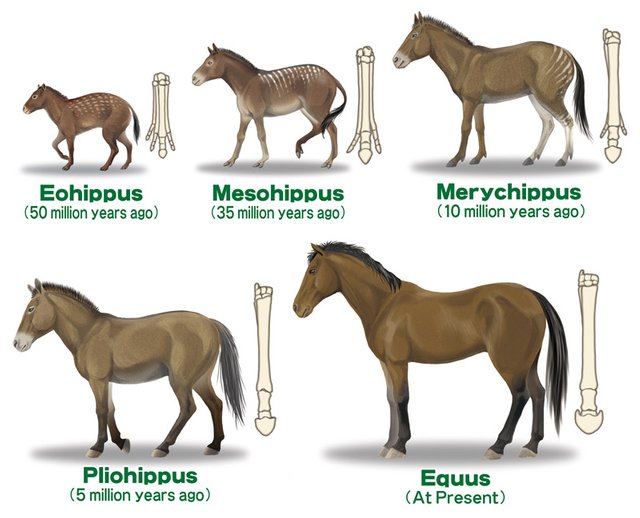
Evolution of the horse
Source
b) Anatomical evidence
Vestigial organs: almost all living beings present some atrophied organs that are vestiges of organs in more or less close ancestors. These vestigial organs are useless and atrophied. In the human body there are more than 100 vestigial organs, among the most important we will point out: the coccyx, the body hair, the appendix, etc. In animals we have that the python snake retains the rudiments of the pelvic girdle and legs of its ancestors; in vertebrates there is a third eyelid, which diagonally closes the eye, which in man is reduced to a fleshy fold with no known use. These organs, due to a modification of the environment or of the way of life, become useless for survival and gradually atrophy.
Homologous organs: homologous organs are of similar origin and structure, but perform different functions. A typical example results from the comparison of vertebrate forelimbs. Homologous organs have a common embryological origin and performed such different functions. Anatomically, they consist essentially of almost equal numbers of bones, muscles, nerves and blood vessels, arranged in a similar manner. This reveals a single plan of structure, which is modified to suit different functions ranging from the fins of a fish to the wings of birds to the upper limbs of man.
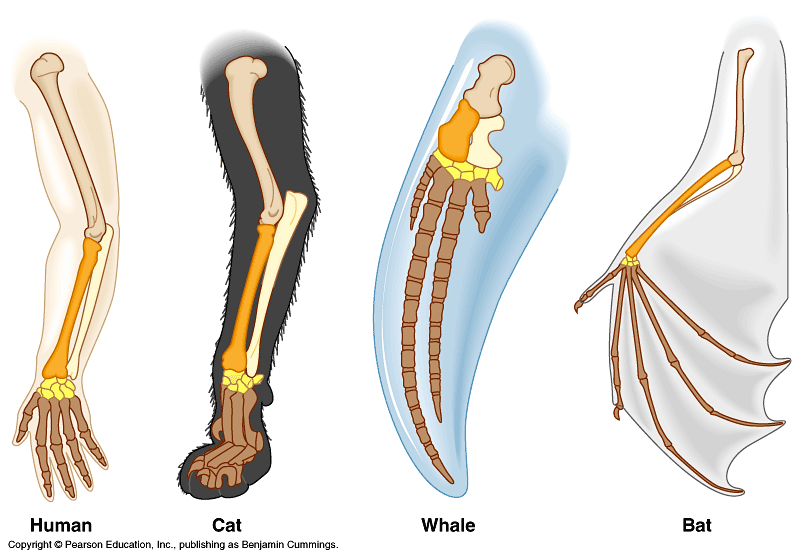
Counterpart bodies
Source
- Analogous organs: are those that have a different embryonic origin, although they perform the same function. Examples of analogous organs are the wings of birds, insects and bats. In all three groups, wings are used for flight, but have different embryonic origin.
c) Embryological evidence
This evidence was pointed out by Darwin and Haeckel. The latter, in 1866, enunciated his Biogenetic Law, which establishes that embryos during their development repeat the history of their ancestors in an abbreviated form. In other words, ontogeny is a rapid recapitulation of phylogeny. Mammalian embryos have many primitive features in common with fish, amphibians, reptiles and birds, so that it is very difficult to distinguish one embryo from another in the early stages of development.
d) Genetic evidence
Experiments on selection in animals and plants by crossing indicate that species are not invariable, as Linnaeus believed, but that some derive from others by evolution or transformation.
It sometimes happens that among the descendants of a given lineage of animals or plants, one or more individuals suddenly appear that differ from the progenitors by some character. This is due to abrupt alterations of the genes, called mutations, which are transmissible to the offspring. It is precisely by the artificial selection of these mutant individuals that most of the domestic breeds of animals and cultivated plants have been obtained.
e) Geographical evidence
The factors involved in the geographical distribution of living beings are a further argument in favor of evolution; therefore, the study of island faunas offers special interest. Undoubtedly, it will be remembered that it was precisely the study of species and animals and plants in the Galapagos Islands that suggested Darwin's evolutionary theory. This evidence is supported by the following arguments.
a) The distribution of species is related to the physical conditions of the geographical environment.
b) There is an affinity between the beings of the same continent or the same ocean.
c) Continental drift. The continents float on plates that are constantly moving. This causes the approximation or separation, as the case may be, over time and as a consequence there are changes in climate, animal migrations and isolation of groups. 250 million years ago, the emerged lands formed a single continent called Pangea.
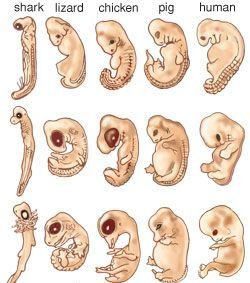
Embryo of different vertebrates
Source
Thank you very much for reading and for your support!!!!(◍•ᴗ•◍)❤
@anyelinasc
Downvoting a post can decrease pending rewards and make it less visible. Common reasons:
Submit